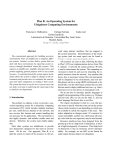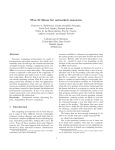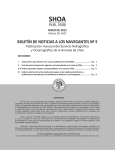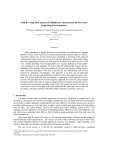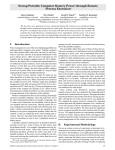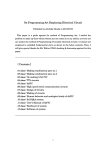Download A New Network Abstraction for Mobile and Ubiquitous Computing
Transcript
A New Network Abstraction for Mobile and
Ubiquitous Computing Environments in the Plan B Operating System
Francisco J. Ballesteros
Eva M. Castro
Gorka Guardiola Muzquiz
Pedro de las Heras Quirós
Laboratorio de Sistemas — Universidad Rey Juan Carlos
Madrid — Spain
nemo,eva,paurea,kleal,pheras @lsub.org
Katia Leal Algara
Abstract
Today, there are several different communication interfaces available and we plug/unplug them at will. However, our network programming interfaces remain similar
to those used when there was at most one network interface.
As a result, applications must struggle with the problem
of adapting to changes in network facilities: they must select the appropriate network, switch to another when the
current one fails, re-establish failed connections, and so on.
Although there are systems and middleware that solve part
of these problems, there is no integrated approach that addresses the underlying problem: a new network programming interface is needed for applications that must run in
mobile and ubiquitous computing environments. This paper
presents the design, implementation, and experience with
a novel network programming interface introduced in the
Plan B’s Operating System and called /net. It also shows
how this addresses the problems mentioned and simplifies
network programming, including some example applications.
1. Introduction
Usually, we expect the operating system (or the middleware) to do both resource management and resource abstraction on behalf of the application. However, in mobile
and ubiquitous environments, the system underlying the application (be it an OS or middleware) does not has much
support for network programming. Mobile devices usually
have multiple communication means available (networks
using TCP/IP over ethernet or 802.11, as well as serial, infrared, and/or bluetooth connections). When an application
wants to communicate with a remote program that is only
reachable through some of the networks available, it must
still know which network to use.
Although we might eventually expect the system to take
over that task, nowadays, the application has to do the system’s job. For example, the network used may be replaced
by another, which might be using a different protocol family (note that it could be just an SMS facility!). In this case,
it is the application that has to detect the communication
problem, discover that a different network is available, and
reroute its data messages through the new network. Once
more, it is doing the work that the underlying system should
be doing. The problem is that the network APIs we use were
designed when it was not common to have multiple networks available, and it was even less common to consider
that they might become enabled and disabled during the application’s execution.
For example, a program sending a print request cares
about the destination printer service used, not about which
network is used to reach the printer. Similarly, a remote execution facility wants just to send commands to the appropriate machine, an editor cares about reaching a file service
to save or load a file, a web navigator cares about reaching
a server, and the list goes on. This does not mean that a program should not be able to specify which network to use;
it means just that the program should not have to. The application might require the network to have certain properties like a reliable transport, high bandwidth, or the like. But
note that needing a network with a particular property is not
the same as needing a particular network.
In this paper we introduce a novel network abstraction,
called /net, that allows applications to specify endpoints in
the network(s), without specifying which network should
be used each time communication happens. Our API also allows networks to be selected based on their properties, making it easier for applications that care about which transport is used. Our system relies heavily on the traditional
file abstraction, per-application name spaces, and the use
of (volatile) late binding. By doing so, we permit the system to switch from one network to another depending on
their availability, without placing the burden on the appli-
cation. Because imposed transparency may be harmful for
the application, we give the application the power to control the extent to which the system will adapt to networking
changes. This control can be exercised to request complete
automatic adaptation, complete manual operation (similar
to programming in other systems), or some behavior in between.
Our approach has been to replace the network abstraction supplied by the system in a way that would be trivial
to port to other operating systems. This way, legacy applications and systems can also benefit from adaptation facilities, and there is no need to adhere to any particular middleware. Furthermore, it took less than one hour to port /net
to the Plan 9 OS, and we do not expect that porting it to
Windows or UNIX should be much more difficult.
The rest of the paper is structured as follows: Section 2
shows the Plan B OS network API, /net, and how it helps
with adaptation. Section 3 further describes how applications adapt with /net, introducing some examples of use.
Section 4 discusses some problems we found. Section 5
gives some measures and implementation details. Section 6
discusses related work. Finally, section 7 concludes and describes our plans for future work.
2. The Plan B’s network API: /net
Plan B [4] is an operating system built specifically for
use in highly distributed and dynamic environments, like
those available in mobile computing and in ubiquitous systems where resources can be added and removed dynamically. It has been designed to interoperate with existing systems and can be used both on the bare machine or hosted
on top of an existing system. Its abstractions are very highlevel, to tolerate implementations on a wide range of platforms going from a native hardware platform, to a Windows, UNIX, or Plan 9 machine. There are a few assumptions underlying Plan B that are important to the design of
its network interface:
There are many alternative resources to choose
among. For each resource wanted, there are many alternatives available. For example, there may be many
network endpoints (reachable through different networks) that might correspond to the service named
/net/myserver:http.
Resources are highly dynamic. The set of resources
available for a given name greatly vary over time. For
example, the system is likely to switch from one network to another while an application is using the name
above.
These assumptions lead to the following principles that
heavily influenced /net:
We use volatile late binding. Names bind to resources
just to perform each operation requested by the application, and the binding is removed as soon as the system call completes. In Plan B, applications use names
(and not handles, descriptors, proxies, or similar artifacts) to perform system calls.
Each application has a name space. Because names
determine which resources are used, and because different applications may have different needs, each application has its own name space and can customize
it. The name space is implemented by an ordered prefix table [20] that specifies name prefixes that map to
the different servers where resources are found.
2.1. Names as tools for adaptation
The first tool provided by the system to the application is
the construction of the per-application name space. As seen
in figure 1, resources are provided by servers (e.g., protocol
stacks) that give names to them (e.g., nautilus:http).
The name of a resource is made of the prefix installed in
the name space, followed by the (suffix) name used by
the server implementing the resource. When the application
makes a call using a resource name, the first prefix table entry that matches the name and has a server servicing the call
is the one used.
Prefix table
tcp
/nautilus:http
/sargazos:fs
/net
/net
...
Infrared
/usr
/nautilus:http
Figure 1. Plan B resources and names.
Each application (or an ancestor) may create or change
its name space by defining names where servers are imported (e.g., /net). We provide two calls for this purpose: import and forget, roughly analogous to UNIX’s
mount and umount. Forget undoes the effect of Import and is not discussed here.
Import gives the application the necessary control over
adaptation. If an application requires using TCP, it may import to /net just the TCP/IP stack. When that application
creates an endpoint, (e.g., /net/nautilus:http), that
endpoint will be serviced by TCP. Should TCP fail, the application will have to cope with that. There is no adaptation
to environment changes in this case.
On the other extreme of the spectrum, an application that
wants fully automated adaptation, and does not care at all
about which network is used, may import to /net all the
known protocol stacks. In this case, the system chooses (on
each call) which network to use. Should one network fail,
the system would choose another that works and use it to
try to reach the peer. For connection oriented transports, the
network is considered to work if a connection can be stablished with the peer. For other transports, the network is assumed to work if it does not report any error while creating
the endpoint or sending to the peer. Note that since the customization of the name space may be performed by an ancestor of the application, the application does not need to
perform the imports itself.
When automating adaptation to changes, it is important
not to loose properties of interest to the application. For example, an application may require a reliable and high bandwidth transport, no matter which network is used. The import operation allows the specification of properties that
must be met by the resources imported to the given name,
as [4] and the Plan B user’s manual in [7] show in more detail. For example, this command or its equivalent system
call
import /net any /net!HByes!Ryes a
would import to the name (prefix) /net any protocol stack
(resources known as /net) that has yes as the value for
high bandwidth (HB) and reliable transport (R) properties.
For each operation performed later to endpoints created at
/net, the system will choose which network to use. The final parameter in the command shown above determines if
the resource is added before or after the ones already installed for that name.
Per-application name spaces are a powerful mechanism
because this permits customizing the environment at any
time. As an example, an application may perform the import
shown above in the hope of using an application-level protocol designed for good connectivity. If all transports labeled
as “high bandwidth” fail, the application will receive an error the next time an endpoint is used. It might then switch to
a “low-bandwidth” mode of operation and change the name
space to request just reliable transports (with no further requirements). Our abstraction enables the strategies used by
systems like Odyssey [11] where the application operates in
different ways depending on the environment. Note that, in
our system, the application would not be disturbed if an alternate transport with the desired properties is available.
2.2. Services, endpoints, and addresses.
The second tool provided by /net to help with adaptation consists of using a single naming scheme and a single
programming interface for all the networks. All operations
performed at /net are handled by the implementer of a
network service. A network service supplies an abstract resource called a network endpoint (actually, it supplies many
of them.) A network endpoint represents a point in the network where data can be sent to or received from. The only
interface for this abstraction is made out of these operations: make creates an endpoint, delete shuts down an
endpoint, and copy copies data to or from an endpoint.
To permit the overlay of networks, our abstraction forces
all endpoint names to be independent of the network used.
Unlike other systems, the application does not have to resolve the name. It supplies the name and the network service is responsible for resolving it. Note that the overlaid
networks do not need to be homogeneous (e.g., IP-based).
Our approach can be used to overlay heterogeneous networks as well, because the interface is high-level enough
to remain independent off a particular network technology.
An endpoint name consists of a machine name, a service
name, and a number. The number is used to disambiguate
names that have the same machine and service names, and
is usually a random number. The translation between machine/service names and network addresses is done by each
network service, not the application. This means that each
network in our system includes a name service to perform
the translation, but we must emphasize that such service is
independent from the application.
The mapping between abstract names and concrete
names is kept in a per-network database with an entry for each machine or entity. In order for this to work,
we must adhere to strict conventions about how to populate this database. For known machines or machines
with known IP-based networks, the names are those translated by DNS. For well knows services, we use an standard
name (e.g., “http”).
For unknown machines or those without (known) IPbased networks, the mapping is network dependant, but follows conventions for uniqueness and legibility. For example, for bluetooth, which requires explicit pairing by the
user, we fill the database with a dns-like name. For services without names, but with a port number, we use the
port number.
There are several kinds of endpoints, depending on the
machine part of their names:
local:svc:N corresponds to a, so called, local endpoint. It represents endpoints created in the local machine to accept new data from other places in the network targeted to the named service svc. Once a peer
has sent data to a local endpoint, such endpoint is
bound to that peer. Therefore, data can be copied to a
local endpoint for replying to a request received from
it. To allow multiple peers to send data to a local endpoint, a process can create multiple local endpoints
with the same service name and different values of N.
Our convention is to use integer values for N, but any
other name can be used.
machine:svc:N is the name for an endpoint created to send data to the named service running at the
named machine, and to receive further data from it.
Once data has been sent through it, the endpoint is
bound for the peer, which means that copying from it
can be used to receive replies to requests sent.
remote:svc:N is not and endpoint, but an artifact
used to learn the address of a peer. It contains the
name for the peer endpoint of the local one with the
same svc and N. The peer name is supplied following
the same naming convention that is used to name endpoints, (i.e., machine:svc:N). Therefore, the name read
from a remote endpoint can be also used as an endpoint name.
all:svc:N corresponds to an endpoint used to send
data to all machines where the named service runs (i.e.,
to perform broadcasts).
2.3. Using /net without Plan B
What has been said considers /net within a Plan B machine. Most of the benefits of /net come from the ideas
underlying Plan B that we described previously in this paper and elsewhere [4]. The network framework presented in
this paper comes from aplying the Plan B’s approach to a
network programming interface.
Nevertheless, using /net without Plan B is feasible and
easy to achieve. The only requirement is to include as part of
the /net framework the implementation of a Plan B name
space. This implementation consists of two small C files
(588 and 308 lines) that implement the prefix table for a
name space.
To support this claim, we argue that the code runs hosted
on top of Plan 9 and has only a few implementation dependencies. We expect that it would be very easy to place it in a
library. The code for the /net framework itself is 726 lines
of portable C code plus some platform dependent code. For
the Plan B implementation hosted on top of Plan 9, the platform dependent code accounts for 423 lines (also in the C
programming language).
3. Using the network and adapting to changes
The code used by a web navigator to retrieve a web page
from nautilus is shown below. Note that, before execut-
ing it, the networks to be considered must be instantiated by
importing them to /net. We show later an example of how
to do it.
// Example code for a web navigator
char req[], repl[]; // data
// 1. create the endpoint
make("/net/nautilus:http:0");
// 2. send the request
copy("/net/nautilus:http:0", 0,
"/mem", &req, sizeof(req));
// 3. get the reply (n bytes)
n = copy("/mem", &repl,
"/net/nautilus:http:0", 0,
sizeof(repl));
// 4. hang up.
delete("/net/nautilus:http:0");
In (1), the program calls make to create an endpoint to
talk to the web service at nautilus. What network is actually
used depends on which ones are imported to /net in the
name space. As far as the program is concerned, the endpoint is created in the first network available that works.
Statements (2) and (3) copy data to the endpoint (sending
the request) and then from it (receiving the reply). We have
to say that /mem is a Plan B resource that represents all the
application’s memory, offsets and lengths have been supplied: the first call is similar to a traditional write, and the
second is similar to a read. Also, note that statement (3)
would have to be repeated because the server reply might
not be contained in a single reply message. But it is worth
considering that both calls use names and that no name nor
operation is specific to a particular network. The interface
is portable across network services, which is very important to enable adaptation.
Adaptation happens while the application uses the network. For example, if the networks imported are those of
figure 1, and both networks are initially available, the client
code shown before would make the endpoint in the first
(preferred) network. Should it get out of service, the network signals an error (probably during a copy call). Because of the signaled error, the system retries the call in
the next network available that is found in the name space.
If any of the networks is connection oriented, the endpoint
(on its own) establishes the connection when needed to send
data. The next section discusses the data loss and duplication issues that can arise due to a network stream reconnection.
For a web navigator, the imports performed might be:
import /net any /net!Ryes b
import /net any /net a
This means that reliable transports would be attempted
first because they are imported before. Should none of them
work, any other transport would be considered, since all of
them are imported after the previous ones. The worst that
can happen is that the user might need to hit reload if an
http request is lost by an unreliable transport. This is an example of an application that prefers to use complete automated adaptation.
A network file server client program, or an editor capable of saving files through the network, should use this instead:
import /net any /net!Ryes b
This means that no unreliable transport would be ever
used for this application. But the system might still switch
between reliable ones.
As a further example, a better network file system client
(in the line of Odyssey [11]), would first
import /net any /net!Ryes!HByes b
and use a mode of operation for well-connected clients (reliable, high bandwidth networks). Then, upon a network error, execute this
import /net any /net!Ryes a
and switch to a poorly-connected machine mode of operation.
3.1. Listening for calls
To complete the description of our interface, a program
servicing HTTP requests would probably spawn several
processes to attend several clients. Each process would execute this code:
// service local:http:0
char addr[Maxaddr];
for(;;){
// 1. make local endpoint
make("/net/local:http:0");
// 2. get the request
n = copy("/mem", &req,
"/net/local:http:0", 0,
sizeof(req));
// 3. log the peer’s address
copy("/mem", &addr,
"/net/remote:http:0", sizeof(addr));
print("peer is \%s\n", addr);
// process the request
do_req(req, repl);
// 4. send the reply
copy("/net/local:http:0", 0,
"/mem", &repl, sizeof(repl));
// 5. hang up
delete("/net/local:http:0");
}
In (1), a local end-point is created. Once created, the endpoint is ready to accept data from the network targeted to
the local http service that we are implementing. In (3)
we show remote:http:0 is the means to retrieve the
address of the peer (if supplied by the protocol). Another
thing to note is that deleting the endpoint would hangup
to the peer. Again, statement (2) should be repeated until
a complete request has been received. The code of a complete http server built along these lines can be obtained from
the web site http://b.lsub.org/ls/planb.html,
serviced by a Plan B system that uses the interface shown
in this paper. Such code is not more complex than the one
shown here, yet it adapts to changes in network availability.
For programs sending requests, the mechanisms described so far suffice to adapt. However, for programs
listening for requests, a mechanism is needed to listen for calls on all networks at the same time. The problem is that a make of a local endpoint (step 1 in the code
above) would create that endpoint only at the first network found in the application prefix table that happens
to service the call. This would make the server unresponsive for other networks that are not the preferred
one.
The mechanism we have used to fix this problem is the
introduction of a mux network that does not correspond to
any protocol stack. Instead, mux is a multiplexor that services local endpoints by using the other networks. When a
local endpoint is created in mux, it creates one local endpoint on each one of the other networks. When a copy is
performed from the local endpoint, it is serviced by trying
to copy from any of the endpoints in the multiplexed networks. That way, a server that wants to listen for requests
coming from any network available, only has to import the
multiplexor network and create its local endpoint there. The
multiplexor then takes care of listening on all the networks
available. Apart from the issue of listening for incoming
calls, the mechanism provided by the names and the interfaces suffices to let servers adapt to the networking environment like clients do.
3.2. Adaptation problems
As shown in the previous section, the first problem we
identified was that switching among heterogeneous networks required the introduction of a multiplexor to listen
for calls from all networks at the same time. When networks are homogeneous, the underlying protocol could still
manage to keep the server listening. For example, when
switching between TCP through ethernet and TCP through
802.11, the listen call used by our implementation kept
the server listening at the given TCP port for all known IP
addresses. Thus, when we switched off one network, the
other was already listening. However, this does not happen
when switching from TCP to a completely different protocol (e.g., bluetooth, IR, etc.). For this case, it is necessary to
implement a listening endpoint as a series of endpoints: one
per network, as described in the previous section.
Another problem is that the timeouts used by the underlying protocols to detect that a network has failed can be
annoying. For example, the longest backoff time for TCP
in the protocol stack we use is 30 seconds. A long timeout is good if we only have one tcp network and are not
willing to hang up our connections easily, before waiting
for the network to recover from a transient failure. However, if our plan is to try any other available network instead, such a long timeout does not work well. In Plan B we
have shortened all such timeouts, because they heavily affect to the overall failover time and should not be bigger
than one second for interactive applications.1 An alternative was to implement a separate mechanism to detect network failures and leave the underlying protocol timeouts
unchanged, but given the network hardware in use today,
it is better to change the timeouts than to provide an alternate detection mechanism.
traditionally to retransmit through the same network). Another problem of this approach is that it can lead to duplicate data under certain circumstances, but that is a different
issue.
Failover may lead to duplicate data being sent. This happens when a network sends the application data and afterwards it signals an error. In this case, the system would pick
another network to send the data through. The result is either a duplicate request or reply being sent. To solve this
problem, we can apply the approach used in Rocks, which
uses a sequencing mechanism to discard duplicate data in
the event of a failover. Although Rocks can failover only
for homogeneous networks (e.g., switching from TCP/IP
to TCP/IP), its sequencing mechanism can also work for
heterogeneous ones. We do not include this mechanism in
our current implementation. Most of the network communication in Plan B is performed to access remote resources
through a protocol called BP [4] that already includes sequence numbers and addresses this problem too.
4. Implementation
application
application
name layer
/net
/net
interface interface
net
mux
protocol
stack
...
/net
interface
...
protocol
stack
Figure 2. Architecture of /net.
A well known problem is how failover affects the data
still in-transit through the network (i.e. data kept in the
buffers of the sending/receiving protocol stacks during a
network failover.) Some systems that permit reconnection
of TCP streams combine buffers and acknowledgements to
ensure that lost data is retransmitted. For example, Rocks
[21] retransmits data when needed after switching from one
TCP connection to another one. Our approach does not need
that additional mechanism to ensure that data has been sent.
In Plan B, when a network signals a failure, the failed operation is retried through another network. This means that
the buffering done by the implementation suffices to perform retransmissions through the new network (like it does
1
It would be better to let the users select how tolerant they are with
problems in their networks. Some might be willing to wait more and
avoid some reconnections; others might be eager to declare a network
offline and avoid waiting before switching to another one. We plan to
explore this issue in the future.
The implementation of Plan B’s /net follows the scheme
depicted in figure 2. Applications talk to the system through
the name layer. This layer implements the prefix table and
is part of the name space implementation of Plan B. When
a call is made, the name layer scans through the application
prefix table to locate any entry that matches the name of the
resource used in the call.
Once a matching entry is found, the operation is tried
in the corresponding server (see figure 1). Should the operation fail there, the operation is retried in the following
matching entry of the prefix table, if any. This means that
the naming layer is overlaying the set of resources available.
Usually, applications import to the prefix /net either
the network multiplexor or some set of networks. Therefore, for calls that refer to names under /net, either the
network multiplexor or a protocol stack would handle the
call. Note that all the networks and the network mux share
the same interface. Namely, the interface provides make,
delete, get, and put calls (The last two ones are used
to implement copy). As it was said, the multiplexor is simply a convenience, to service “listen” requests for multiple
networks. It performs make requests for local endpoints on
each network when a mux receives a request to create a local endpoint on it.
The network interface is abstracting the underlying protocol in a portable manner by supplying the operations mentioned above. Figure 3 shows this. An application would
use endpoints implemented by the network interface modules of figure 2 that map to concrete network endpoints supplied by a particular network or protocol stack. In figure 3,
application
Abstract net interface
endpoint
endpoint
Concrete networks
TCP
IR
TCP
endpoint
endpoint
endpoint
Figure 3. Endpoints and /net.
the abstract endpoint on the left may be one provided by the
multiplexor, which created two different endpoints to listen
at two different networks; the one on the right is the typical endpoint created by any other network interface. How
this abstraction works is described in the following sections
where we show how it is implemented. We do so by discussing how each operation is performed for each kind of
endpoint.
tempt to reconnect to the remote peer. Should this attempt
fail, an error condition is signaled (which usually makes
the system switch to a different network). This retry-once
mechanism is useful for reestablishing broken connections
on working networks and also allows the system to detect
non-available networks (those that fail multiple times) in a
reasonable time (this would trigger adaptation by switching to another network).
The implementation of a delete operation is as easy as
closing the connection, if any, and destroying any underlying resource used for the destroyed endpoint.
4.2. Non-local endpoints
Non-local endpoints are implemented like the ones described above. However, the implementation expects an initial copy of data to the endpoint before copying data from
it. Once some data has been sent, the network implementation has an established connection to the peer, and the application is allowed to copy (receive) data from it.
Connection break handling and the retry-once mechanism work as shown in the previous section.
4.1. Local endpoints
When a local endpoint is created, due to a call to
make, the network interface binds a port to the service and
announces it. The port used depends on the name used by
the application (that is translated by an entry in the db resource). A further copy from the endpoint is implemented
by listening for an incoming call and accepting it in the
case of connection-oriented networks. In any case, the implementation does a receive in the protocol stack involved
and services that data to the copy operation. Note that since
local endpoints are created to accept incoming requests,
the implementation does not admit a copy to a local endpoint before some copy has been performed from it.
After the first data have been received, the network interface implementer creates a (fake) remote endpoint matching the name of the local endpoint used, and places into it
the address of the remote peer. This is to let the application know the address of its peer, should it care.
The implementation keeps the local endpoint bound to
its peer until the connection breaks (for connection-oriented
networks); or until a further copy operation is performed to
receive more data (for datagram networks).
While the endpoint is bound, further copies to or from it
are implemented by sending or receiving data from the corresponding endpoint in the underlying network. The remote
address where data is sent to (or received from) is that of
the bound peer. When the connection breaks (or when it is
a datagram network), the implementation makes a single at-
4.3. Broadcast endpoints
Broadcast endpoints only admit copy of data to them (not
from them). The implementation uses the broadcast primitive of the underlying network to send the data. If the underlying network does not support broadcasting, a creation of
a broadcast endpoint fails, and the system retries the operation in another network. For the user, the operation works
as long as one network imported to the name /net supports broadcasting.
4.4. Raw endpoints
What has been described suffices for 99% of the applications. For the 1% that requires a complete control over
an underlying network, each network provides a raw endpoint. A raw endpoint has the name raw:none:N and is a
hook right to the underlying network. The application is expected to copy requests into this endpoint and then copy
replies out of this endpoint. The set of requests is dependent on the network used, and is similar to a traditional interface like [14].
We have to say that none of the applications we use for
our daily work would require the usage of this kind of endpoint if ported to Plan B. None of the ones already written
or ported make use of it.
5. Evaluation and experience
In this section we show the evaluation made for the system and outline the experience we gained by using it.
5.1. Performance evaluation
We introduce several sources of overhead with our approach that we measure in this section. All measurements
mentioned below have been performed on a 2.4GHz Pentium 4 PC running Plan B hosted on a Plan 9 system. To
avoid interference from the networks, we have used loopback ones. All figures below correspond to the average of
100 measures taken while the machine was idle. The clock
used to obtain the time is based on the time stamp counter
register of the processor. This register counts at the processor speed. The kernel used this as its source of time. We read
the counter from user code by reading its register. The overhead of reading a register is negligible with respect to the
measurements.
500
450
400
350
300
Latency
250
(microsecs.)
200
150
100
50
0
×
×
•
•
Plan B /net×
×
•
•
×
Plan 9
0
×
•
•
×
×
×
•
•
×
•
•
100 200 300 400 500 600 700 800 900 1000
message size in bytes
Figure 4. Message latency for Plan B /net and
Plan 9, for different message sizes.
It is not feasible to compare measures made to our implementation with measures made to a traditional socket interface, because that would require either implementing /net
on a traditional system or implementing a traditional network abstraction in Plan B. Instead, we obtain an upperbound on the overhead of using /net by comparing our
system while running hosted on Plan 9 with the underlying Plan 9 system. The measured overhead includes both
the overhead of /net and the overhead of using a hosted
implementation. The measured throughput for such setup is
the same for our approach and Plan 9; our overhead is seen
in the observed latency. Figure 4 shows the latency (in microseconds) for sending different message sizes (up to 1000
bytes). The solid line corresponds to a Plan 9 program that
used the Plan 9 network API. The dashed line corresponds
to the analog Plan B program, running on a Plan B hosted on
the same Plan 9 platform. On average, the latency of /net
is 44.2 s worse than the Plan 9 one. But as we said, this is
a very conservative upper bound for our overhead, because
this time includes many more crossings of the user-kernel
boundary than a native version would have.
To provide a optimistic lower-bound for the overhead
of /net, we considered just the overhead of resolving
names each time the interface is used (instead of permanently binding names to resources). To measure this, we
executed the info("/net") system call, that simply resolves the name and returns metadata for the named object.
The result is 28.7 s in our machine for the complete system call, and 27.7 s if we remove the part that resolves
the name, which means that it takes 1 s (in average) to resolve a name in the prefix table. In a system that has binding
(i.e., on systems other than Plan B) this 1 s can be avoided.
We thought this time would heavily depend on the number of entries installed in the prefix table, however, measurements show that the actual time spent in the search is
negligible with respect to other factors (such as the length
of the name being resolved, or the number of interrupts that
the machine serviced while searching the table.) This makes
sense if we think that each prefix found before the one actually used implies just another string compare operation.
Fortunately, this overhead is not significative, if we compare it with the time employed by the underlying protocol
stack and the network device.
What has been said applies to an operation in the absence
of failures. When a network fails, there are sources of overhead, discussed below, that are unavoidable and have to do
with the tasks needed to perform a reconnection.
The time needed to perform a failover to a different network depends on both the time needed to detect that the
current network fails and the time needed to switch to a different one. Both times are specific of the underlying protocol stacks and are not introduced by our approach. The former is considerably larger because it involves timing out a
failing network. The call that happens to use a failing network for the first time suffers the whole delay. Subsequent
calls recognize the network as failed and take just the time
to switch to the new network. The failure detection time can
be on the order of seconds and is imposed by the underlying network protocol. In Plan B the delay is two times bigger, considering the retry-once mechanism.2
The time to switch networks depends on the network we
are switching to. This time corresponds exactly to what it
takes to initialize a new endpoint for use in the new network
and is also unavoidable. Its value is what it takes for the par2
We plan to let our users select between being tolerant with transient
failures or not. A user adjustable parameter would simply impose a
maximum on the timeouts used by the protocol stacks to tolerate transient disconnections.
ticular protocol stack to create its end-point, and makes negligible the time to allocate the abstract end-point data structure. In the hosted Plan B we have used to measure performance, /net takes 1.337 s to create an endpoint (this includes creating it, binding an address it, and listening on
it); The underlying Plan 9 platform takes 0.678 s to do the
same operation.
We have measured the time to retrieve a web page using the Linux HTTP client wget against a server running
on Linux, Plan 9, and Plan B. The machines involved were
2.4GHz Pentium 4 PCs connected through 100Mbps Ethernet. On average, it takes 22ms for Linux, 26ms for Plan
9, and 26ms for Plan B. Although this measure accounts
not just for /net, but also for the differences in the ethernet drivers, the TCP/IP stacks, and the OS kernel, it suggests that /net is competitive with respect to other systems.
Taking into account the measured overhead and the benefits of our approach (both simplicity and the ability to
adapt) we consider that it is worth using /net for network
programming in dynamic environments.
5.2. Experience
We have used /net to access services using a protocol
similar to those of network file systems, called BP [4]. In
addition, we have been using applications to exercise the
interface, including a web server, as well as remote access
for audio devices and their volume controls. We have found
that the interface is extremely simple to use while making
our applications much more resilient to changes in network
availability. Furthermore, applications that do not include
even a single line of code for adaptation to network changes,
become adaptive. The import mechanism allows us to tune
the adaptation for them, as we saw before.
The final interface presented in this paper may look obvious, but it is not. We made many mistakes that we found
only after using the interface. Most notably, in our first version, we did not provide a means to hold multiple connections to the same remote endpoint, and had to introduce the
final number in the endpoint names to disambiguate). Also,
we did not foresee that a multiplexor was needed. The way
to map abstract endpoints to underlying connections, and to
learn peer addresses, evolved heavily as we were using the
API, before reaching the model presented in this paper.
6. Related work
Both Plan B and its /net framework are heavily influenced by Plan 9 [13] and its network interface [14]. Plan
9 uses a portable file-like interface as its network interface, which is considerably simpler than other APIs including sockets [18] and Java Streams [10]. Our interface is no
more complex than the Plan 9 one (and may be simpler!),
and unlike the systems mentioned, we are able to switch
to different networks as the environment changes. Unlike
our system, both Plan 9 and the systems we mention below
keep file descriptors, socket or streams descriptors, or object references, after the initial setup of their network endpoints. We use names and do not use descriptors. Therefore,
the systems mentioned either do not adapt or have to introduce more software to re-introduce an indirection between
the application and the network. They lost such indirection
when they decided to use descriptors.
Some researchers have suggested to introduce more
binding levels to help in issues like routing and location of network destinations [16]. Our proposal is just the
opposite, to almost remove binding.
Many middleware systems like One.World [5], Linda
[2], Jini [19], and INS [1], include services based on tuples or attributes that permit the application to locate resources in the network in a portable way, which might permit adaptation. Other systems like Globe [8, 6] rely on distributed objects or introduce proxies to admit adaptation.
But it is unclear how network programming could be performed with these systems for conventional applications
that are not programmed for their middleware. Consider
for example typical servers and clients for web, mail, distributed editing, and so forth. Our approach differs in that
we do provide a system-level interface to do network programming while still making it straightforward to adapt.
In fact, the biggest difference between our approach and
most related work is that we provide a generic mechanism
to adapt (dynamic name prefixes for resources modeled like
files, together with volatile late binding) that is applied to
the network endpoints as well as to any other resource in
our system. It just happens that our generic mechanism, designed for adaptation to changes, also addresses the concrete problem of adapting to changes in networking.
It might seem that Speakeasy [22] is related work, but it
addresses a different problem and is unrelated to our work.
We focus on a new network programming interface and its
underlying abstraction. Speakeasy and other related technologies are something that could be implemented by using
our abstraction. They are more potential users of our work
than direct competitors.
DHT’s [15] are being used as a complementary abstraction for network addressing, resource location, and remote
access to resources, but it is not clear how this mechanism
could provide a network programming interface like our approach does.
There are many works about overlaying networks (e.g.,
RON [3] and Rocks [21]) to help re-route connections transparently through homogeneous networks. Unlike such systems, we provide an integrated approach that also works
for heterogeneous networks. Systems like Vertical Overlay
Networks [17] use several networks at once, trying to use
the one that works best at any time. This is similar to /net
in that it would adapt to changes in network availability. It
is different in that the networks considered are still homogeneous. Also, their mechanism applies only to networks,
and ours is also used to adapt to changes in other resources
[4]. All that has been said applies as well to Rocks [21],
MSOCKS [9], and MobileSockets [12], that add an extra
layer of indirection between the application and its network
connections. They switch only between homogeneous networks. They do not handle issues like naming and heterogeneity of interfaces that are necessary to map between the
application view of the world and the addresses and names
used by the different networks.
Another difference between our work and the systems
mentioned is that our approach can be used both when the
users can afford switching to a different operating system,
and when the users do not want even a single modification
of their operating system kernel. This is due to the fact that
Plan B can work either as a native system or as a hosted system running on top of another.
7. Conclusion and future work
The contributions of this paper are the introduction of a
new abstraction for network programming, the description
of its implementation, a description of a generic approach to
adapt to changes in the network, and a description of some
example code to user our system.
Plan B /net uses a volatile late binding mechanism, coupled with the use of a high-level interface that is provided
at the system level for the resource considered (the network
in this paper). It provides adaptability and can switch from
one network to another without disturbing the application.
Per-application prefix tables permit control over adaptation
so that the transparency provided may be controlled instead
of getting in the way of the application and becoming harmful.
It would be useful to gather statistics about networks and
to be able to use them to choose the network to be used.For
example, it would be interesting to be able to use the cheapest network, or the more reliable one, or the one with a highest available bandwidth, etc.
We are currently working on the second edition of the
Plan B operating system. We have an operational system
hosted on top of Plan 9, and a native port for Intel PCs is
underway. In the future we plan to port more applications
to our system as well as to port our /net framework to more
systems.
References
[1] W. Adjie-Winoto, E. Schwartz, H. Balakrishnan, and J. Lilley. The design and implementation of an intentional naming
system. Symposium on Operating Systems Principles, 1999.
[2] S. Ahuja, N. Carriero, and D. Gelernter. Linda and friends.
IEEE Computer, 19(8), Aug. 1986.
[3] D. Andersen, H. Balakrishnan, F. Kaashoek, and R. Morris.
Resilient overlay networks. Proceedings of the 18th SOSP,
2001.
[4] F. J. Ballesteros, G. G. Muzquiz, K. L. Algara, E. Soriano,
P. de las Heras Quirs, E. M. Castro, A. Leonardo, and S. Arvalo. Plan B: Boxes for network resources. Journal of Brasilian Computer Society, Special issue on Adaptable Computing Systems To appear.
[5] R. Grimm and B. Bershad. Future directions: System support
for pervasive applications. Proceedings of FuDiCo, 2002.
[6] H. J. S. I. Kuz, M. Steen. The globe infrastructure directory
service. Computer Communications, 25, 2002.
[7] LSUB. Plan b web site, 2001.
[8] A. S. T. M. Steen, P. Homburg. Globe: A wide-area distributed system. IEEE Concurrency, 1999.
[9] D. Maltz and P. Bhagwat. The jini architecture for networkcentric computing. INFOCOM, (3), 1998.
[10] S. Microsystems. Java 2 platform standard edition, api specification.
[11] B. Noble, M. Satyanarayanan, D. Narayanan, T. J.E.,
J. Flinn, and K. Walker. Agile application-aware adaptation
for mobility. Proceedings of the 16th ACM Symp. on Operating System Principles, 1997.
[12] T. Okoshi, M. Mochizuki, Y. Tobe, and H. Tokuda. Mobilesockets: Toward continuous operation for java applications. Intl. Conference on Computer Communications and
Networks, 1999.
[13] R. Pike, D. Presotto, K. Thompson, and H. Trickey. Plan
9 from Bell Labs. EUUG Newsletter, 10(3):2–11, Autumn
1990.
[14] D. Presotto and P. Winterbottom. The organization of networks in Plan 9. In USENIX Association. Proceedings of
the Winter 1993 USENIX Conference, pages 271–280 (of x
+ 530), Berkeley, CA, USA, 1993. USENIX.
[15] S. Ratnasamy, P. Francis, M. Handley, R. Karp, and
S. Shenker. A scalable content-addressable network. Proc.
ACM SIGCOMM, 2001.
[16] J. H. Saltzer. On the naming and binding of network destinations. Local Computer Networks. North-Holland Publishing
Company. IFIP, 1982.
[17] M. Stemm, R. H. Katz, and R. Morris. Vertical handoffs in
wireless overlay networks. Journal of Mobile Networks and
Applications, 3(4), 1998.
[18] Stevens. Unix network programming. Prentice-Hall, 1998.
[19] J. Walso. The jini architecture for network-centric computing. Communications of the ACM, 42(7), 1999.
[20] B. B. Welsh and J. K. Ousterhout. Prefix tables: A Simple
Mechanism for Locating Files in a Distributed System. Proceedings of the 6th ICDCS, 1986.
[21] V. Zanty and B. Miller. Reliable network connections. Mobicom 2002, 2002.
[22] W.K. Edwards, M.W. Newman, J.Z. Sedivy, T.F. Smith,
and S. Izadi. Challenge: Recombinant Computing and the
Speakeasy Approach. Proceedings of the 8th ACM Mobicom, 2002.










